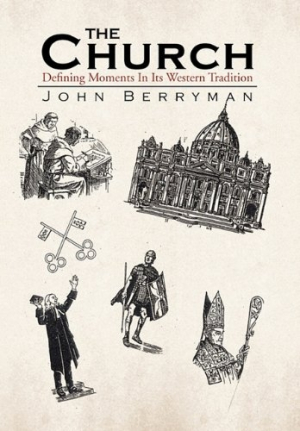The Church
Defining Moments in Its Western Tradition
To present the history of the Catholic Church in a single, slim volume is a daunting task, but to do so in an eloquent and entertaining manner is nothing short of a miracle. John Berryman performs just such a marvel in The Church: Defining Moments in Its Western Tradition.
Berryman’s whirlwind political narration of 2,000 years of the Catholic Church is neither rushed nor plodding; it is measured and well-paced, with more than five-hundred footnotes that support his evidence and his conclusions. Each of the book’s twenty chapters centers on what Berryman calls a “defining moment” that determined the direction the church would take for the next century or so.
Only a few of his selected moments are ecclesiastical in nature. Most of them deal with the rise or fall of a king or emperor (Charlemagne, Napoleon), a military event (Constantine at the Milvian Bridge, the Crusades), or the establishment of a holy order (the Benedictines, the Inquisition). Not all of Berryman’s “defining moments” are, on the surface, clearly influential. The untimely death of Arthur, Prince of Wales and heir to the English throne, which led to the coronation of his younger brother as Henry VIII, is one such moment for both the Church of Rome and what would become the Church of England.
Berryman writes clearly and succinctly. He rarely injects his own opinions, and when he does, he backs them up with statements by historians from the medieval chronicler Froissart to the contemporary historian Norman Davies. He also freely quotes from Edward Gibbon, St. Augustine, and numerous popes and scholars, and he provides a chapter-by-chapter bibliography that points the reader to his sources.
In his twenty “defining moments,” Berryman shows the “tenacity” with which the church fought and continues to fight to survive, grow, and remain relevant in an ever-changing world. As he notes early on, “what is astonishing is not so much that the church sustained its hold over the Western world for well over a millennium, but that its tender shoots survived the upheavals in its Mediterranean nursery over the first 250 years or so of its existence.”
The Catholic Church is the primary focus of Berryman’s book, but the author has not neglected its offshoots, although he gives far more space to its Anglican and Methodist branches than to its American, Orthodox, or other limbs. Berryman is often critical of the church for its corrupt, repressive, and “corporate” policies, the latter referring in particular to its acquiescence to the policies of Hitler, Mussolini, Franco, and lesser fascist dictators. However, he notes and praises the revitalization of the church and the “rediscovery” of its original mission under Popes John Paul, Paul VI, and John Paul II. The author concludes his work with how the church is coming to terms with female ordination, homosexuality, celibacy, birth control, and other key issues of the day.
Berryman deserves high praise for accomplishing a monumental task with grace, style, and selective detail that makes his work worthy of a place on the shelf with that of other great historians.
Reviewed by
Mark McLaughlin
Disclosure: This article is not an endorsement, but a review. The publisher of this book provided free copies of the book and paid a small fee to have their book reviewed by a professional reviewer. Foreword Reviews and Clarion Reviews make no guarantee that the publisher will receive a positive review. Foreword Magazine, Inc. is disclosing this in accordance with the Federal Trade Commission’s 16 CFR, Part 255.

